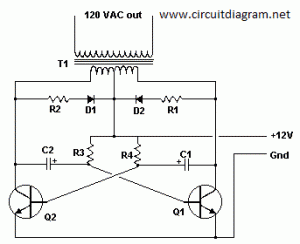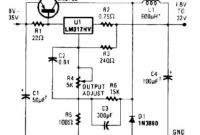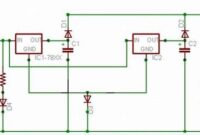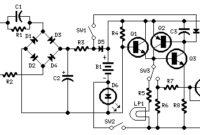The following diagram is the basic design diagram of inverter circuit. The circuit will convert 12V DC to 120V AC. This basic inverter circuit can handle up to 1000Watts supply depends the T1, T2 and transformer used. Please see the note.
Basic Inverter Components list:
| Part | Total Qty. | Description | Substitutions |
| C1, C2 | 2 | 68 uf, 25 V Tantalum Capacitor | |
| R1, R2 | 2 | 10 Ohm, 5 Watt Resistor | |
| R3, R4 | 2 | 180 Ohm, 1 Watt Resistor | |
| D1, D2 | 2 | HEP 154 Silicon Diode | |
| Q1, Q2 | 2 | 2N3055 NPN Transistor (see “Notes”) | |
| T1 | 1 | 24V, Center Tapped Transformer (see “Notes”) | |
| MISC | 1 | Wire, Case, Receptical (For Output) |
Notes:
1. Q1 and Q2, as well as T1, determine how much wattage the inverter can supply. With Q1,Q2=2N3055 and T1= 15 A, the inverter can supply about 300 watts. Larger transformers and more powerful transistors can be substituted for T1, Q1 and Q2 for more power.
2. The easiest and least expensive way to get a large T1 is to re-wind an old microwave transformer. These transformers are rated at about 1KW and are perfect. Go to a local TV repair shop and dig through the dumpster until you get the largest microwave you can find. The bigger the microwave the bigger transformer. Remove the transformer, being careful not to touch the large high voltage capacitor that might still be charged. If you want, you can test the transformer, but they are usually still good. Now, remove the old 2000 V secondary, being careful not to damage the primary. Leave the primary in tact. Now, wind on 12 turns of wire, twist a loop (center tap), and wind on 12 more turns. The guage of the wire will depend on how much current you plan to have the transformer supply. Enamel covered magnet wire works great for this. Now secure the windings with tape. Thats all there is to it. Remember to use high current transistors for Q1 and Q2. The 2N3055’s in the parts list can only handle 15 amps each.
3. Remember, when operating at high wattages, this circuit draws huge amounts of current. Don’t let your battery go dead :-).
4. Since this basic inverter project produces 120 VAC, you must include a fuse and build the project in a case.
5. You must use tantalum capacitors for C1 and C2. Regular electrolytics will overheat and explode. And yes, 68uF is the correct value. There are no substitutions.
6. This circuit can be tricky to get going. Differences in transformers, transistors, parts substitutions or anything else not on this page may cause it to not function.





this is fabulous and fantastic. Most of this components are sub-standard in Africa.
I am building this circuit for a class project. My teacher wanted me to filter and smooth out the square wave to sin wave using low pass filter. I was wondering if you can recommend placement of the filter and the size of inductor and capacitor used to do this? I hope you can help me out here. Thank you!
Good day Sir, would like to ask your help if you could share to me a simple inverter circuit diagram that has a capacity of 15Kilowatts. 24volts dc input and 240volts ac output. i would highly appreciate it if you could help me. Thanks and more power..
good evining sir,
i have to design a small size inverter.so plg tell me what a best components to design a inverter& which process is best to design a iverter?
can the low quality transistor be efficient to use coz some of these components are a bit expensive to buy.
can you tell me what transistors to use to get 1000 watts?
please is TIP3055 and 2N3055 of the same capacity?
Sir,
i want to need 12v to 240v 1000v inverter circuit diagram. plz, send all components detail for me. the transformer and transistor rating and also, send battery detail for these requirements.Finally, i have an one doubt this is pure sine wave inverter circuit.kindly, send to me.
I have a home inverter. I think it works normal during daytime. At times, during night, when mains power fails the inverter switches to UPS mode. Even when mains power comes back, the inverter does not switchs back to ‘Mains power’ mode but hangs in ‘UPS mode’ for quite some time and much later, say around 6.30 in the morning the inverter switchs to ‘mains power’ mode. Please let me know what could be the problem – whether the inverter does not work properly when the voltage is high or low because my hunch is that the supply may be high or low late in the night when the general usage is less. Thanks for your help.
sir please tell me how it work and please send me for more power invertor about 100kwatt
good day sir,am really thanking God for using people like you to inspire me. I am a student of the federal university of technology akure wit matric no PMT/O8/5127.please can the transformer removed from a 9V radio be used as the T1?and wat shld be the voltage rating of the capacitor to be used?my E-mail is prosperlomo25@yahoo.com.thanks
sir, i use normal capacitor but the capacitors are brust,2nd can i use the old UPS transformer?please help me .thank you
i dont really have any question now but i like dis web,is interesting
hi friends
help to me
friends i have few doubt on this inverter circuit…plz help me to clear..
1.where i connect battery in this circuit?
2.how to recharge the battery?
3.rectifier circuit need for this inverter?
friends do the needfull..
i eagerly awiting for your comment…
I love assembling utile info, this post has got me even more info!